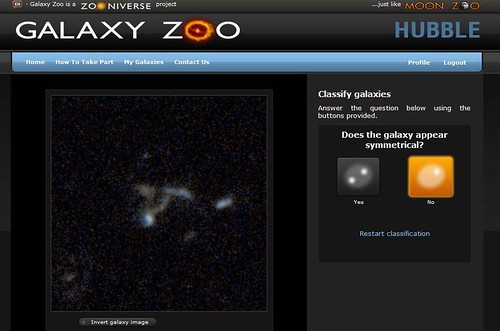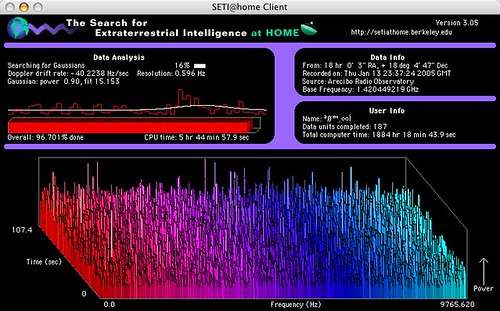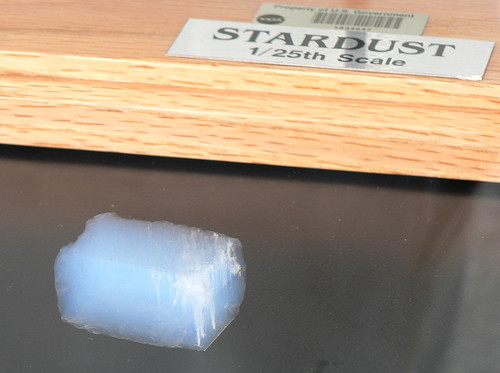Be a scientist!
- By Sara Mitchell
- October 8, 2010
- 2 Comments
In one of last week’s contests, we asked our readers/followers/listeners (whatever you guys are – we love you!) to tell us about the things they’d like to see covered here on Blueshift. And we got tons of interesting ideas that’ll fuel a bunch of our weekly brainstorming sessions! One of the suggested topics that came up more than once was what we often call “citizen science,” or opportunities for anyone, anywhere to get involved with a big scientific effort.
Over a decade ago, I remember using SETI@home as my screensaver. I ran their software and donated my computing power (and my university’s bandwidth) to analyze radio data for signs of extraterrestrial life. I’d come back to my computer and watch the data being crunched (it was often more interesting than whatever I was about to use the computer for), wondering if something unusual would be found. I felt connected, even involved, in this scientific effort. SETI@home is on the edges of citizen science, as it’s more about harnessing computer power than human power. Citizen science is all about the citizens!
Today, there’s an ever-growing list of science outreach programs designed to give anyone who’s interested the opportunity to contribute and/or analyze data. It’s a big enough field now that there are even conferences about it! When we had a small earthquake in the DC area, I blogged about using the U.S. Geological Survey’s citizen science project to report what I felt. I’m going to briefly introduce three space science efforts that anyone can get involved in. If there’s interest, I can blog about more in the coming weeks!

Image credit: Gwydion Williams
One of the ones nearest and dearest to astrophysicists’ hearts is Galaxy Zoo, which allows anyone to look at data from the Hubble Space Telescope and classify the galaxies that they see. You get some brief training, and then look at images and answer questions about the objects within them. Sounds deceptively easy, but some of the images have weird stuff in them! Check out the story of Hanny van Arkel’s voorwerp – a mysterious object found by a Galaxy Zoo volunteer that we covered in a round-up a few months ago.
Next up is Stardust@home, (which is run by some of the same folks as SETI@home, so the name sounds similar) which uses citizen scientists to look for tiny particles of interstellar dust that are embedded in the aerogel collector brought back by the Stardust spacecraft’s sample return capsule. It’s tricky business that requires human eyes and brains to discern the precious dust among flaws, cracks, and other issues in the aerogel. But it’s working – they’re finding candidate dust tracks and scientists are eager to analyze the material that likely originated in distant stars, light-years away.
Finally, NASA has started a citizen science project called Be a Martian. In a system that feels a bit more like a game than a data analysis program, you’re not just any citizen – you’re a Martian citizen, and your job is to count craters and match satellite imagery of the planet’s surface. By getting the public involved, data analysis speeds up immensely.
Like in any scientific endeavor, you’re going to look at a lot of data without making any amazing discoveries. The joy of participating is really in being a part of something interesting and important, and bringing the whole analysis process that much closer to the big discoveries. But what do you get if you find something amazing? It depends on the program, but I can say that Stardust@home has some good perks – naming rights and co-authorship on the scientific paper that announces the discovery. And their top-ranked volunteers can come visit their lab in Berkeley, CA, if they’re in the neighborhood. How cool is that?
Have you participated in any of these citizen science projects? Have any others to recommend? Want me to blog about more? Talk back in the comments!





Excellent post! I’ve participated in each of these (ranked in Top 100 in earliest days of StarDust,) as well as several others, including three other BOINC projects to which I still contribute. But, my favorite Citizen Science project will probably always be the SpaceWatch Project’s FMO Project, which ended in early 2006. (http://fmo.lpl.arizona.edu/FMO_home/index.cfm)
Each night, volunteers would download images, obtained by the Kitt Peak observatory, to search for “fast moving objects.” Dozens of NEO, asteroid, and comet discoveries and recoveries were made by the volunteers. I wish I could convey the anticipation of waiting for those images, and the thrill of scrutinizing the starfields, trying to find that undiscovered asteroid or comet. Though always black and white and “unprocessed,” the images were always stunning and often included other intriguing objects, such as quirky-looking galaxies, bright clusters, even satellites. I never made any discoveries, but I feel privileged to have participated in the search.
Tavi, that project sounds fantastic! The excitement of getting your first look at data like that is definitely something I love about participating in citizen science. Even working at NASA, citizen science is my best means of participating in research – my time at work is spent translating scientific work, not doing it. But I geek out over doing a bit of it, too, and these projects are so fun!